#ameraucana hen
Photo

An Ameraucana hen, boldly and fully-feathered.
She is prepared for the harsh Midwestern winter.
Unlike most breeds, their combs and waddles are hidden under feathers, which makes them perfect for cold climates.
#midwest#autumn photography#chickens#birbs#birblr#birdland#birdlovers#chicken#hen#ameraucana hen#chicken portrait#farmcore#chicken photography#cottagecore#chicken posting#hens#poulette#pullets#animalphotography#original photography#original photography on tumblr
247 notes
·
View notes
Photo

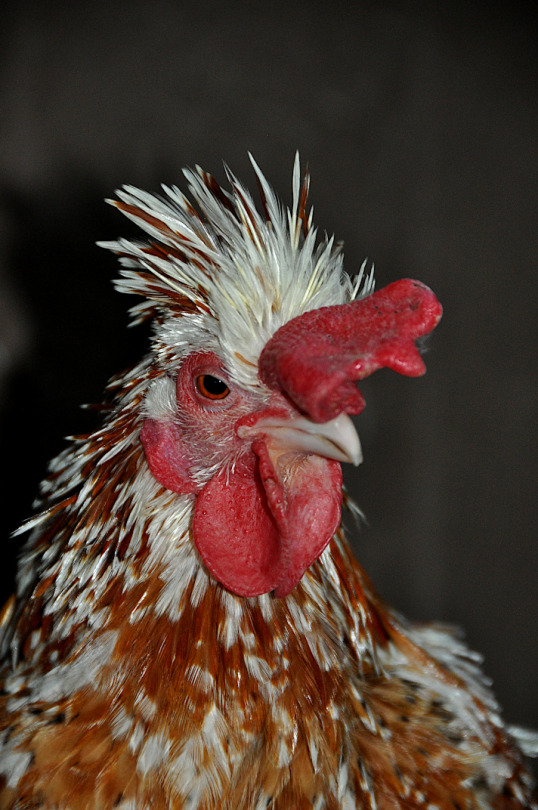
We finally got rain today! This is their reaction.
To be fair, they are older chickens. However, their pen has dry areas and their sleeping area is snug and dry. Still... disgruntlement.
#Nickel#Ameraucana hen#Quilt#Pyncheon rooster#photozoi#orig pics#10-2022#old chickens#Nickel is 6 or 7 we think#Quilt is 8 or 9#chickens
12 notes
·
View notes
Text
*static noises*
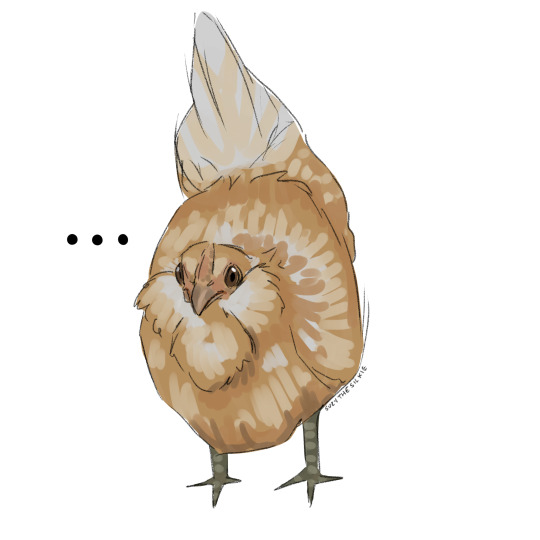
132 notes
·
View notes
Note
My naem is chicke
Im blak n red
I ware a com
up on my head
I eat a seed
An somtiems mice
Et my own eggs
(But onlee twice)
An wen I wants you dead on site
Mi dino blood is in full light

#I have nothing else to add this is perfect! DSFDSFDSF!!#Not quite an exact likeness of Harpy but a good stand in for the terror herself. I only have very fuzzy photos like some tiny cryptid#Chickens#Chicken keeping#Poetry#Also you somehow managed to get her coloring right! Most of our hens were Ameraucanas and were a delight (if not a little bloodthirsty)#But Harpy was all bloodlust and short on the delight - except for when she delighted in trying to rip something or someone to shreds#WAIT FUCK I RHYMED AGAIN 2 TAGS UP ^#Oh gods the Seussian Sickness is setting in. And I haven’t even watched The Grinch yet
20 notes
·
View notes
Note
Hi! 😁 I might soon have the chance to have a garden and I've always wanted to have a few chickens, and I've started some online reasearch about keeping chickens but since you're an expert and I don't trust some of the online sources, do you have any tips for absolute beginners? 😅
I do! You can have a garden, or you can have chickens, but the two are diametrically opposed forces that do not coexist peacefully without fully enclosing one or the other. Chickens can and will obliterate gardens and landscaping if they have access to it, including absolutely destroying mulch patches by helping you spread it all over the yard.
I'll put the rest under a cut ^_^
When you acquire chickens, don't get them from a hatchery, get them from a small breeder you've looked into and spoken with about their actual birds. Hatcheries have poor quality animals, so while you may be getting a "black copper marans," they're not gonna necessarily look very nice, and they're almost certainly not going to lay that nice, deep chocolate marans are known for.
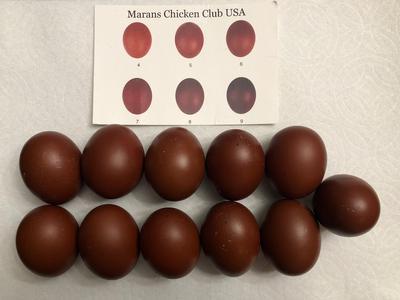
Vs straight from one of the bigger hatcheries pages, photos of their eggs:

You also are NOT going to get the breed qualities of any given breed except maybe some of the production breeds. For example, a Jersey Giant from a reputable breeder will get up to 10-13lbs, which is as big or bigger than my peafowl. Same with Brahmas and Cochins. Hatchery stock you will be lucky to see 6-8lbs, and people are OFTEN disappointed about this kind of thing. Silkies, as another example, can look WILDLY different from a hatchery vs a private breeder. A show quality silkie is a puffball:
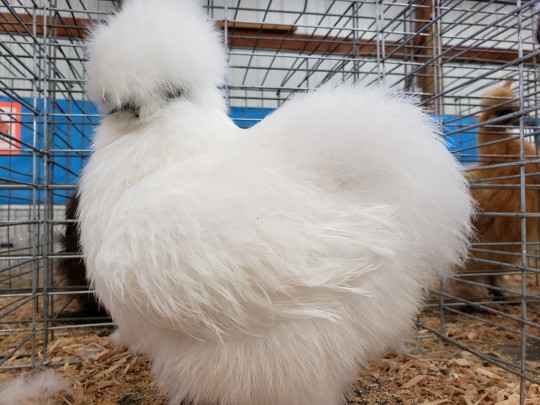
Hatcheries also pull skeevy moves like calling easter eggers (mutts that lay blue, green, pink, brown, or white eggs) "americanas" hoping that you mistake it for "ameraucana" the pure breed that lays stark blue eggs. Then they charge you ameraucana prices (like, $25/chick) when they should be charging more like $3-5 a chick. They'll do things like call a marans/barred rock mix a "mystic marans" as if it's a new color morph of a marans chicken instead of a mixed breed mutt they invented to be able to sex their chicks at hatch easier. People get these guys expecting MARANS eggs, and they get tan barred rock eggs. Same can go for temperament and behaviors. You go anywhere that has a group of chicken owners and ask them what their favorite breed is, you will get a range of answers with reasons like "my X is so sweet" while the next person will go "mine's the devil" and if you ask, 9 times out of 10, it's hatchery stock birds. Well bred private breeders often have MUCH more stable temperaments.
vs hatchery stock
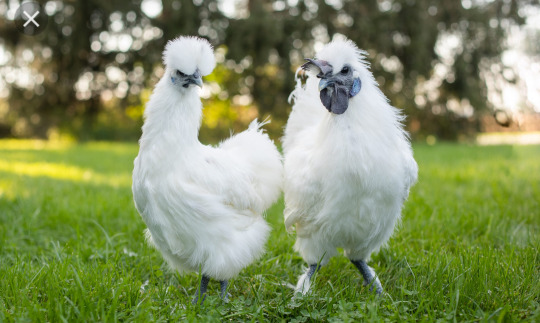
Getting from a private breeder also lets you get eggs, which can help you dodge a LOT of disease bullets. There's very little that transfers through the egg, strangely, and some of that is transferred on the surface of the eggs (like mycoplasma) so a quick santizing dip before incubation gets rid of that. I know that hatching them yourself is more of a hassle, but so is losing your flock to newcomers that came in with something entirely avoidable if you'd hatched instead. If your breeder is NPIP certified, they're getting tested for the major egg-traveling problem (pullorum) and a dip will take care of most anything else unless you're super SUPER unlucky.
Lastly on acquisitions, be prepared to get roosters. If you can't have roosters, be prepared to get them processed for yourself for food, or let the roosters go to food homes. Please please please please. There are so many, many excess roosters. They cannot all go to homes. The rooster to hen ratio in a flock is like 1:9. The rooster to hen ratio in hatching is nearly 1:1. Let someone make use of them. EVEN if you order from a hatchery, and order all pullets, they can make mistakes and send rooster babies. It's not a guarantee! Have a plan in advance! Mentally prepare yourself! Don't be one of Those People making posts in local groups about how you don't want/can't have this rooster but also no one else can eat it either. Chickens are a lot of things. Sometimes food is one of those things.
BEFORE actually acquiring the chickens, locate a vet that will see them. You are GOING to have an issue at some point in their lives, and that's not the time to start looking for a vet, that's the time to already have a vet on hand. In fact if you can support a yearly wellness check on at least one of the birds to test for communicable illnesses (like mycoplasma) and have a good relationship with your vet in advance, that's even better.
As for care, if you plan to contain the chickens, the minimum recommendation for a backyard coop and run varies wildly. For stress purposes, most chickens will find 4 feet of floor space per bird inside the coop adequate, accompanied by 10 square feet of space in a run per bird. Unlike peafowl, it doesn't matter how big the run is, the chickens will be turning the entire thing to bare soil, which is one of the reasons most people don't keep both in the same pens. I literally attempted to keep 2 standard chickens in a 1200 foot pen and they systematically went about destroying everything they could get to.
Most layer feeds are 16% protein; most layer feeds are also /production/ layer feeds, meant to feed production breeds in a space where they get NO other feed except this. If you plan to feed anything other than layer feed to them, like treats or whole foods or scratch grains, then you need to find a higher protein feed for them, because most treats are lower protein than layer feed. Avoid anything produced by Purina or Dumor (which is purina but TSC brand), except MAYBE the organic dumor 5-grain scratch grain, it's well-known as one of the worst quality fowl feeds out there. Check out your local mill and see if they have any options that are better than the big box farm stores. Kalmbach makes good feeds, as does Belstra.
Possibly counterintuitive, but stick with a smaller waterer over a larger waterer. You can keep a larger one around for if you go away for the weekend or something to make it easier on a sitter, but a smaller waterer like a 5-quart or gallon waterer will be easier to clean and make sure that you're giving fresh water more often, plus avoiding mosquitoes growing in it. Waterers can slime up really easily in the summer, so just be prepared to give it a quick swish clean every time you change the water out. Smaller waterers also make it easier to give them medication if you have something that goes in the water, especially since a lot of the water medications are "make fresh daily." Personally I don't bother with heated water bases anymore in the winter, I just have enough waterers to exchange them for a fresh one a couple times daily, while the old one thaws inside the back door on some plastic. The galvanized ones you have to use with the heated bases always got gross fast, with rust and discoloration and the stopper in the bottom always dried out and eventually cracked over the summer when we weren't using them.
Try to avoid straw bedding unless you REALLY trust the source. Straw is mostly for livestock, not poultry. It cannot catch the droppings of poultry the way shavings or sand or other beddings do, meaning the wet gunk drops to the floor under it and/or collects into grossness. It also molds easily, can carry in field parasites (since it's not treated the way shavings are often kiln fired before packaging), and breaks down into shards. I'm not saying you can't ever use it for any reason (I use it in some fashion, and have for over a decade, but not exclusively, and I trust my source, we've never gotten mites or anything, and I'm very careful about which bales I pick out), but if you have a choice, go for the wood substrates, or even for sand. A lot of people put sand in their runs because they can then rake it like kitty litter.
Look into what plants chickens can't have, and check your yard over thoroughly for them before adding chickens. Things like lilac bushes are toxic to them. Tomato and potato plants are nightshades so while they can have the fruits, the leaves and stems can be toxic. Stuff like that.
Lastly.... if anyone ever makes a claim about what something does for a chicken (example: diatomaceous earth, apple cider vinegar, pumpkin seeds, oregano, red pepper flakes, lavender, etc are all things I've seen people claim do all sorts of things from worming birds to curing respiratory infections), ask them for their source. If it's a blog post, ask them for a scientific article. If they can't provide it and you can't find one that backs up what they're saying, maybe reconsider the value of that particular advice. The thing is, the BIG production companies are VERY invested in finding cheap or organic or tricky ways to do WHATEVER it is (treat endo/ectoparasites, treat illness, make bigger or more eggs, change egg yolk color, etc), and they pour money into trying to figure out which old wives tales actually work and which ones don't. And if they haven't been able to prove it to a point where they'll spend money on it as a solution, then chances are REALLY GOOD that it's not a solution at all actually.
Things like how to clean coops, what feeds to get, what items to use for care, where to source birds, behavioral information etc, that's all stuff you can ask advice on in general public spaces. You'll still get a range of answers, and some of them will be garbage answers, but hardly any of them will do harm to your animals to do or not do. Like, for example, you can use a big waterer or a small waterer, as long as it's clean. You can vary coop and run size and still be fine. You don't have to feed exactly what someone else is feeding for your birds to be fine. You're probably going to try a few breeds before you find the one(s) you like best.
But when it comes to medical info or any kind of "treatment" type stuff? Consult a vet and/or at least look for scientific papers.
And lastly.... chicken math is Real, yo. However many chickens you think you want to get, plan on having the space for double that amount so you don't gotta rebuild anything when you ultimately decide wait, you need a couple more. The bigger space won't hurt them if you don't get more, but it'll be so much easier on you if you do ;)
227 notes
·
View notes
Text
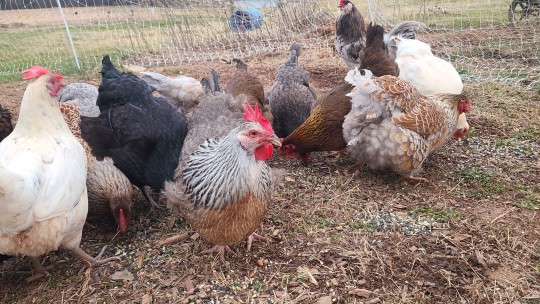
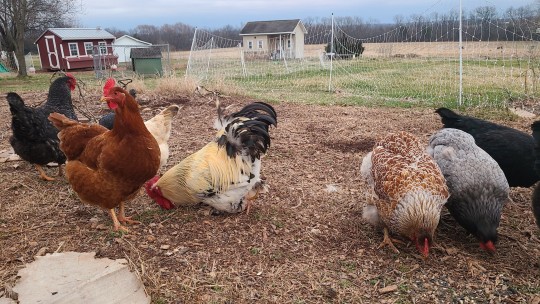

The chickens are chasing after some nice treats, and cultivating my garden for me. They don't dig up the weed roots much, but they do subject them to constant heavy stress, making them easier for me to deal with later. Of course, they also leave a little fertilizer. Not a lot, as this is not their usual hangout, but chicken manure is very high nitrogen and you don't really need a lot anyway. It doesn't really add significant organic matter, unlike ruminant manure.
In the third photo, you can see a grey chicken with a bright red comb and large fluffy "muff" on his chin. This is our Ameraucana roo, doing his job and keeping his head up while the ladies dine. You don't need to keep a rooster, and a loud or aggressive one can be a real pain, both for the keeper and the hens. But a good one keeps everyone feeling less stressed and can be a genuine defense against predators.
20 notes
·
View notes
Text
The E locus in Chickens!
The E extension locus is the locus that determine the base pattern in chickens. I will show you all some examples of E locus alleles from most dominant to most recessive. The E locus controls the extension of black eumelanin and gold phaomelanin on a bird. Some genes extend black over more of the bird and some restrict the black to certain areas and extend gold. Some of these are actually mahogany (Mh) instead of gold, and not all of these pictures are stellar. I'm doing my best.
E: Extended black. Extended black is the most dominant and darkest of the base patterns. It has been debated what an extended black would look like without additional melanizers. Black birds that you see at shows are solid black like this hen. These birds are usually E based, but black can actually be created on most loci, with enough melanizers.
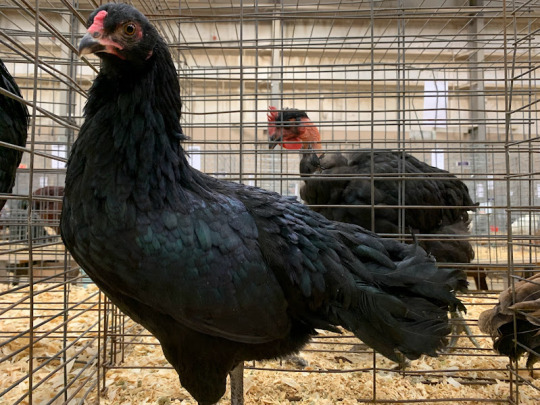
But it is theorized that males without melanizers might have some gold leakage in the hackles, shoulders, and saddles like this guy. I believe he is mahogany based.

And hens might have a little gold in the hackles. Extended black also gives birds epidermal melanin in the beaks and shanks.
E^R: Birchen is the second most dominant and the second darkest of the E alleles. It causes a mostly black bird. The hen has gold edging on the hackle feathers, along with down the front of the neck and breast.
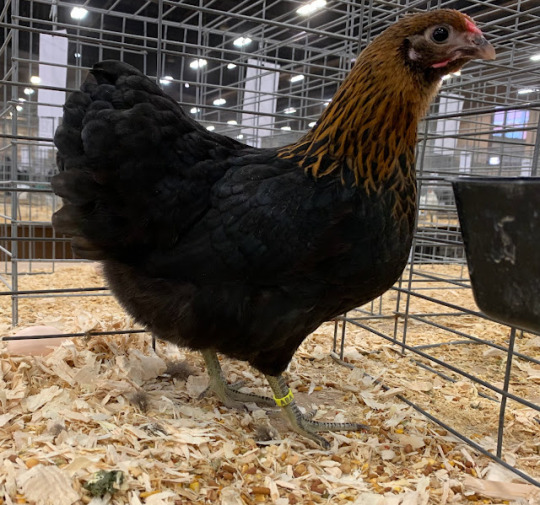
On males it is much the same except the gold also extends to the shoulders and saddles as well:
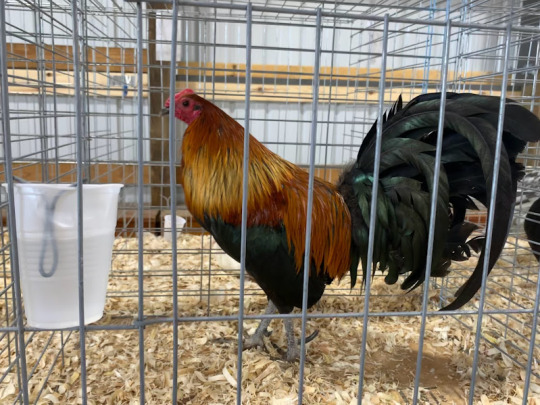
This guy is lacking the breast lacing. I think it might be caused by some type of melanizer.
Birchen is a very cool base color because of all the patterns that are based on it. With a few other genes, you can get spangled birds, laced birds, and autosomal barred birds all with fully patterned tails. Also, it is often conducive to dark facial skin and eyes with the id+ gene.
E+: Duckwing. This is the wildtype pattern, what red junglefowl are: gold duckwing. Proving that wildtype is anything but basic.
Hens are a stippled brown with salmon breasts and gold necks with black striping
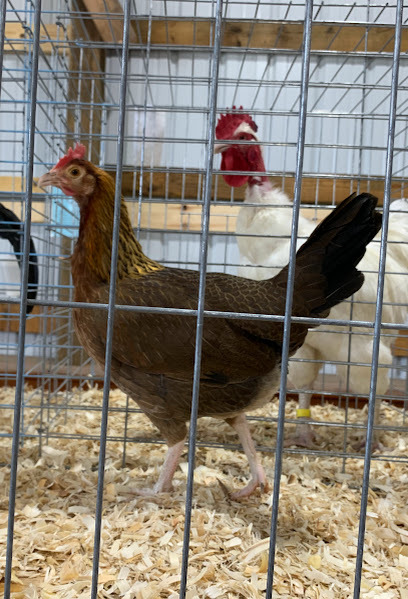
A male will have a black breast and tail and a gold neck and saddle. His wing is what "gold duckwing" gets its name for. He has red shoulders/bows, a black wing bar and a bay-colored wing bay.
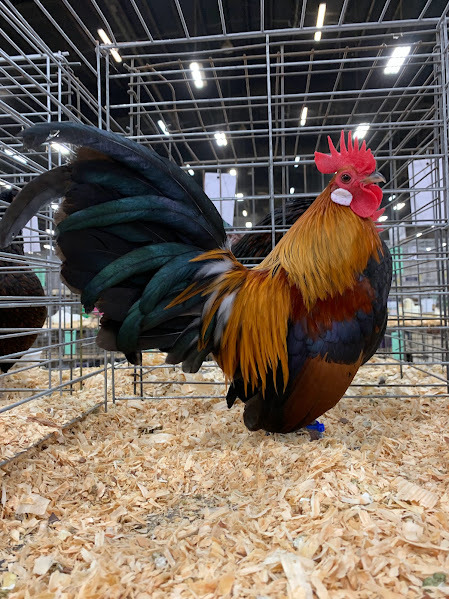
e^Wh: Wheaten. It is theorized there may be more than one wheaten allele. In my experience, it is incompletely dominant with duckwing. It is the lightest of all of the colors on the e locus. I think it looks very cool and exotic and has an interesting level of sexual dimorphism. Blue wheaten is one of my favorite colors.
The females are a lovely creamy color like this Ameraucana from the Ameraucana Alliance page (because apparently my only wheaten photos are blue wheaten or red wheaten.)

Also from the Ameraucana Alliance page, Susie Winder's Wheaten Male. Wheaten males and duckwing males can be hard to distinguish unless you know their background.
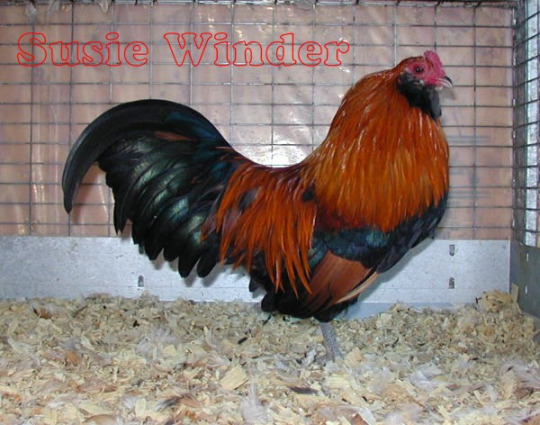
Since white has the most gold extension, it is the best base for creating patterns like buff and black-tailed red.
e^b: Partridge. The most recessive of the e alleles. Darker than e+ but lighter than E^R. It is hard to find one without the pattern gene. Partridge takes pattern well but always has a black tail.
Females are the same color as gold duckwing but with brown stippled breasts instead of salmon breasts. Here is a partridge Drents hen from Kippenpagina.
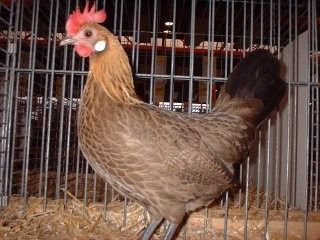
Partridge males are much the same as gold duckwing, except with a touch more black in the hackle. Also from Kippenpagina.
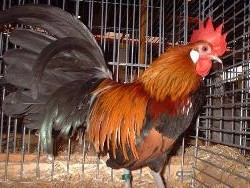
#finding a picture of#partridge#is what made me put off the#e locus#for so long#chickens#extended black#birchen#duckwing#wheaten#chicken genetics#bird genetics
17 notes
·
View notes
Text

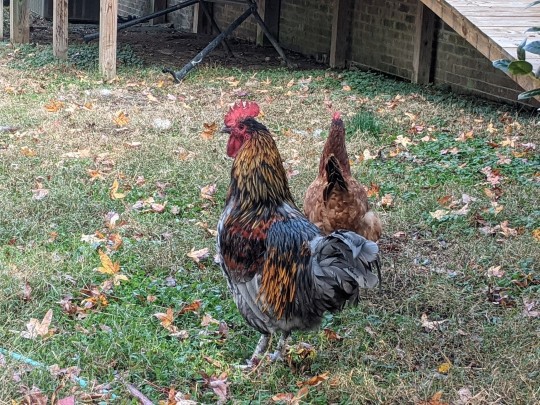
New rooster, free from a stranger who was moving & couldn't take him. He was delivered by his former owner and even came with a red hen who laid an egg on her very first day here (and most days since) so A+ deal really.
I haven't been able to get a pic that really shows his size, but him BIG, dwarfing all the hens and even our other rooster. Also he is beautiful; I hope he works out with the flock long term. We don't know what he is really, beyond that he hatched from a green egg, so there is Ameraucana/Easter Egger in him.
So far he's no trouble to us or the dogs, but upon release from introductory chicken jail he immediately set about stealing all the bitches from poor Maurice. There's been a bit of fighting between them, which I assume will settle down once they work out the new social order, but I've been sending Omie to break them up whenever I see it.
J named him Big Rico, so naturally his wife is now called Lola, even though she'll be indistinguishable from our other reds once her back feathers grow back in.
16 notes
·
View notes
Text
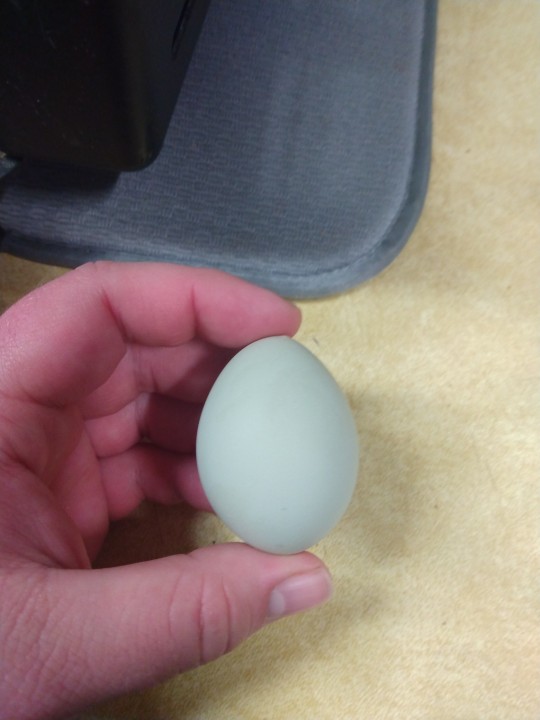
Look at this tiny blue chicken egg I found today 🥺🥺🥺🥺 I have no idea who layed it, maybe one of the old ameraucana hens? None of them have layed any eggs in a year or two, maybe this was all she could muster up? She did a great job 😭🖤👍
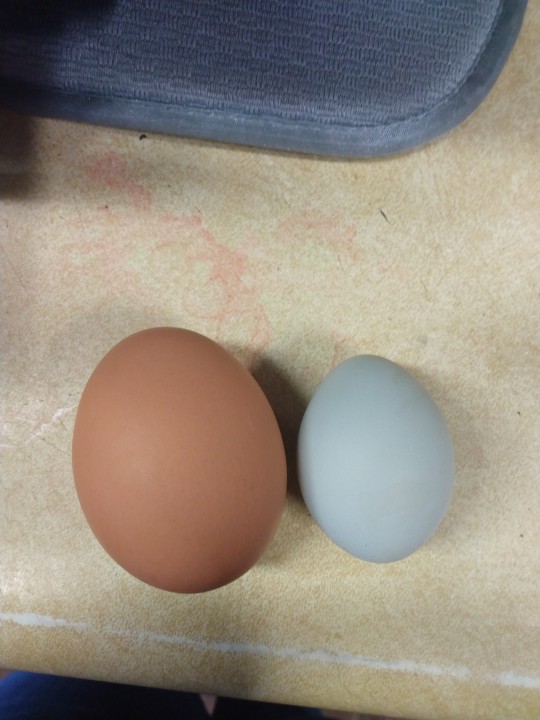
Size comparison
8 notes
·
View notes
Text
I was going to add this to this post, but I realized I was just restating a lot of it in my own words with the occasional extra thought. But I still wanted to post this.
-----
I love birds dearly. I'm studying to become an ornithologist, and I would never own a parrot, or parakeet, or any other "exotic" bird. I simply do not have the means to provide everything a non-domesticated bird needs. Very few people do, unless they have the money, time, and space for an enclosure genuinely comparable to a zoo or wildlife center aviary.
These are wild animals. They have needs even the best zoos can't completely satisfy*. They are not domesticated. They are not built to live in people's homes. Birds, especially parrots, have intelligence comparable to people, and yet they are so different from us on such a basal level. They cannot live a good life any other way than the way they've evolved to.
*(Though they are still VERY well cared-for and captive populations are necessary to protect species from extinction. Without zoos we would be without so many more species on top of what we've already lost. That's not to mention just how far that exposure to these animals goes when it comes to stirring compassion and activism.)
They belong in their natural habitat with other members of their species. And if that can't be accomplished because of population and/or habitat loss, then at the very least in a high-quality zoo where they're treated like animals, not pets.
Chickens, doves, and other domesticated fowl are bred and built to thrive in captivity. If you want a pet bird(s), get something that's domesticated. It will actually live a fulfilling, happy life, instead of always feeling like something is deeply, deeply wrong with its life, but being unable to change it. Not to anthropomorphize TOO much, but I think a lot of us can empathize with that feeling in this modern era.
~~~~~
I've kept chickens and would so love to do so again when I have a yard again. They're delightful, and the variety of breeds available is extremely fun. Personally I recommend ameraucanas -- they have cheek fluff/"beards", they're very cold-tolerant, and lay green and blue eggs :) And they don't need extra care like Polish, silkies, or other breeds with crazy feathers that get dirty easily.

And if you're totally unfamiliar with chickens, there are two sizes of most (if not all?) breeds: standard and bantam. Standards are the big ones you're likely familiar with, while bantams are maybe half or a third the size. So if you're pressed for space, get a flock of four or five bantam hens of your preferred breed and you're golden :)
Socialize them when they're chicks and they'll adore you when they're older. They have their own personalities, and they'll turn your kitchen scraps into eggs lol (just... double check before feeding them anything that it's safe for them). A mature hen can and will lay an egg a day when she's happy and healthy (no rooster needed), which is actually another reason to go for bantams instead. Smaller eggs (~1/2 the size of standard eggs) means their output is easier to keep up with. And if all else fails, you can sell the eggs too. Fresh, homegrown eggs have better color and flavor so there WILL be demand for them.
8 notes
·
View notes
Photo
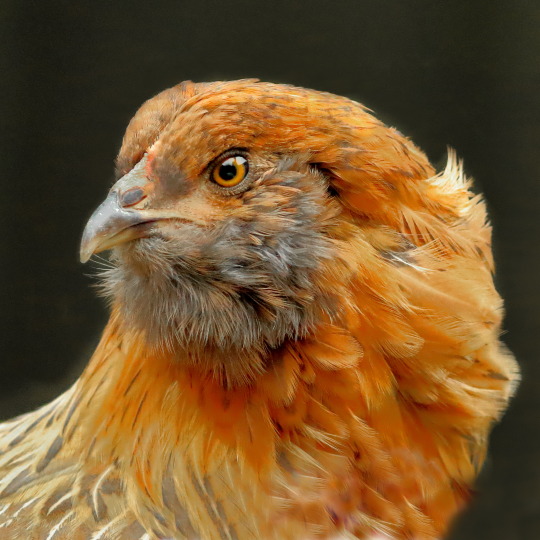
Portrait of an Ameraucana Hen
This young hen has yet to lay an egg. However, her plumage is already coming in nicely, and is reminiscent of a raptor-like bird.
#midwest#springtime#chicken#chickens#chicken portrait#chickenposting#ameraucana#chicken photography#chickenlover#hen#poulette#chickenpic#chickenpicture#chickenphotography#farm animals#farm photography#rural photography#kura#huhn#poulet#la gallina#original photography
3K notes
·
View notes
Text

The Face of Fog
#Fog#Ameraucana Bantam#hen#chicken#photozoi#original photo#2-2024#she runs the henyard#Fort Featherly Flock#Beak Bunk Biddy
714 notes
·
View notes
Text
Chimkin update! :D

Sweet baby Morgoth the Destroyer sitting with her mother <3 She'll come running when my sister goes out to the coop >v>
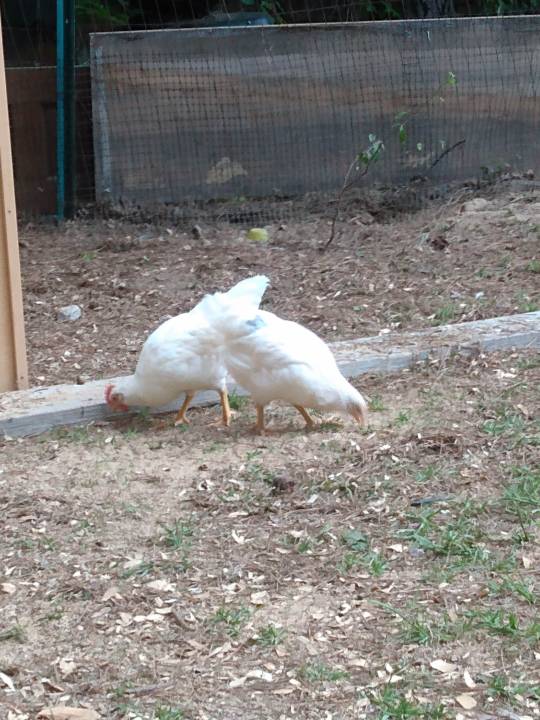

Snowflake and Pretty Boy on patrol around the coop, being such responsible and protective roosters.

Jeff is filthy from digging and a sibling looks on in alarm.


A new named fledgling! This is Olive; she's friends with Morgy and has started to follow my sister around like Morgy does :D She's still not quite as comfortable being held or petted like Morgoth is, though.
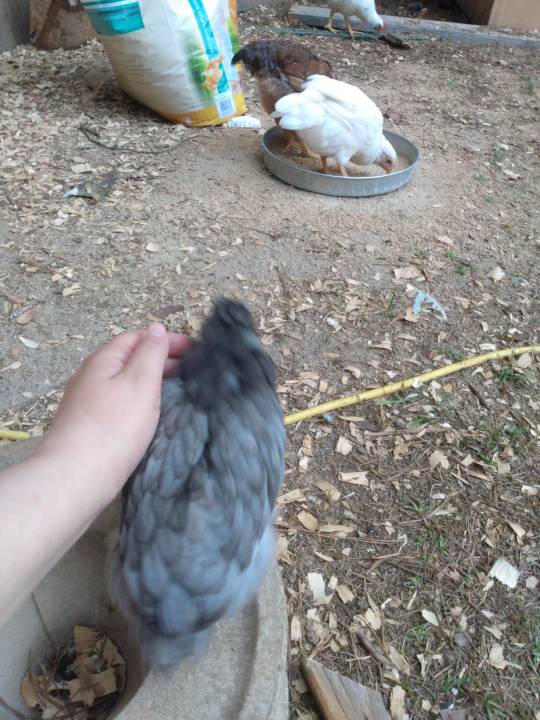

Morgy demands pets and attention.

Morgy and Olive together; Morgy's a bit smaller due to her scissor-beak making it more difficult for her to eat, but she's still growing well :3
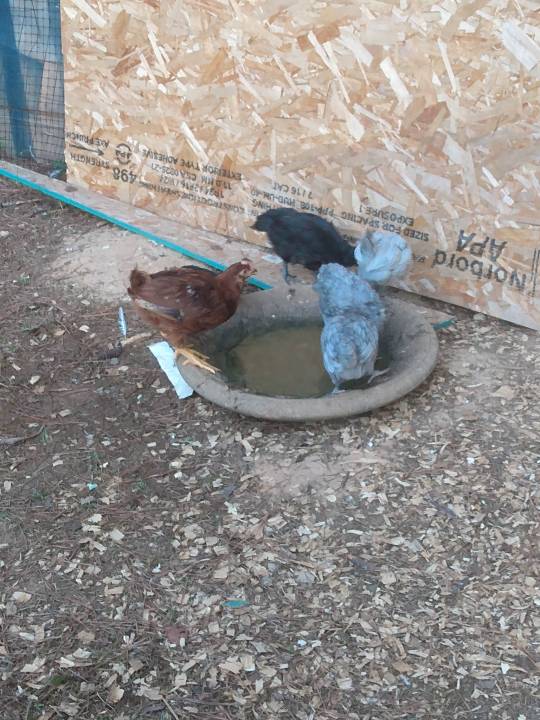

Cinnamon is still putting herself in charge of watching the fledglings.


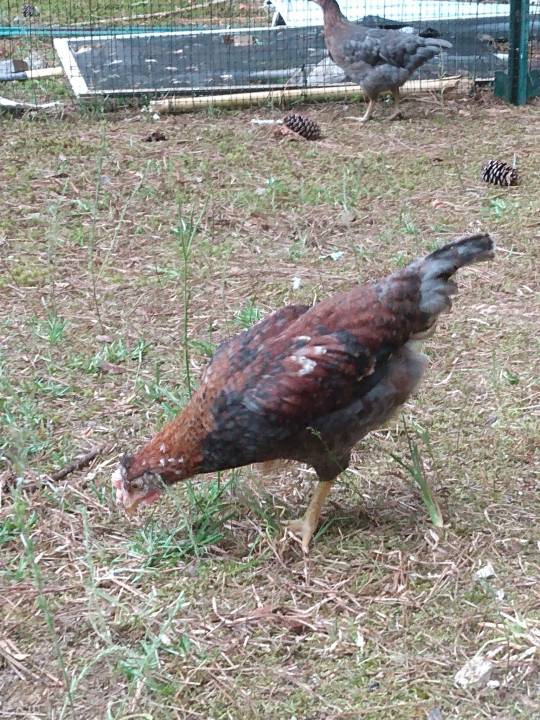
Hennifer the maybe-hen/maybe-rooster being utterly massive. The ultimate unit.

Bean, the blessed child, always giving such sass.
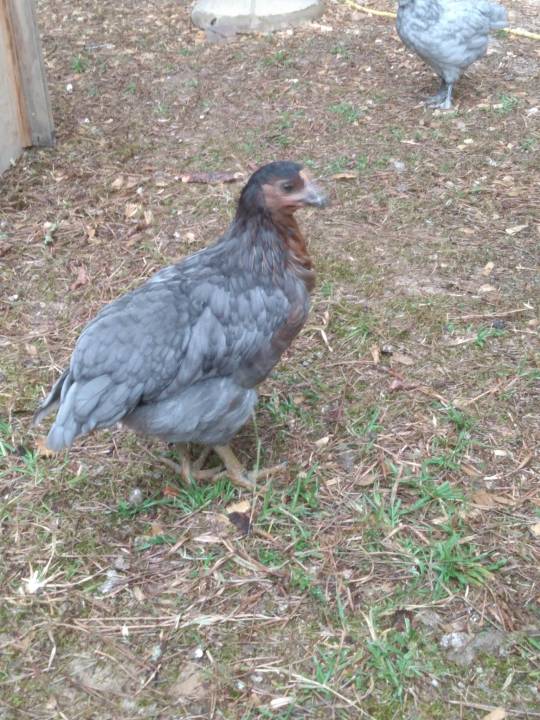
Grub is also a chonk.
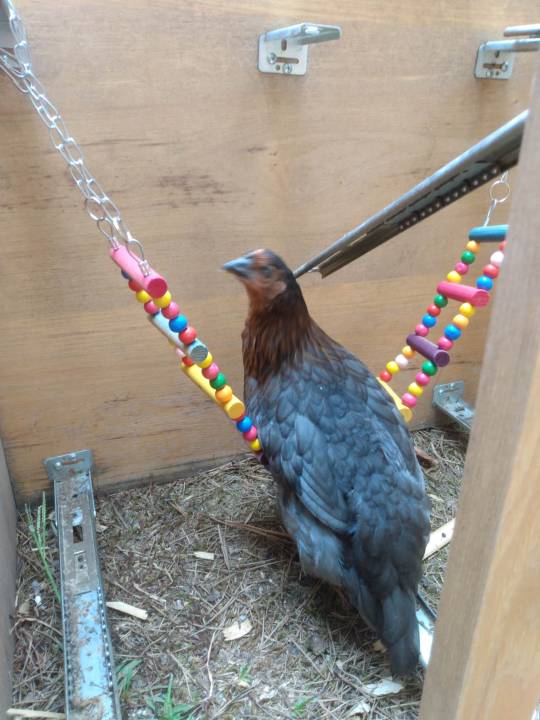
You've heard of worm-on-a-string, get ready for Worm on a swing. :)
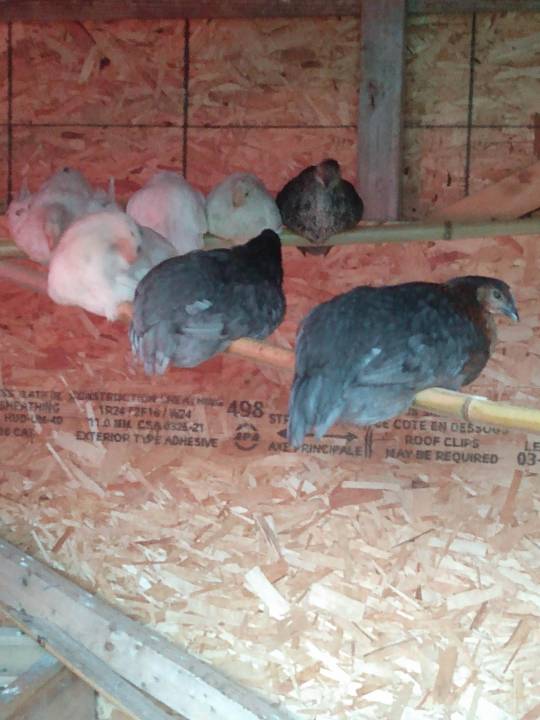
They tend to roost in pairs: Grub and Worm, Jeff and Bird, Snowflake and Pretty Boy. And then another friend that I can't see well enough to name lol

A stand off between I believe Peanut and Walnut.

Grub has found a crevice to crawl into.

Indominus Rex is finally starting to look like a proper chicken and not a crow! She's very beautiful uwu
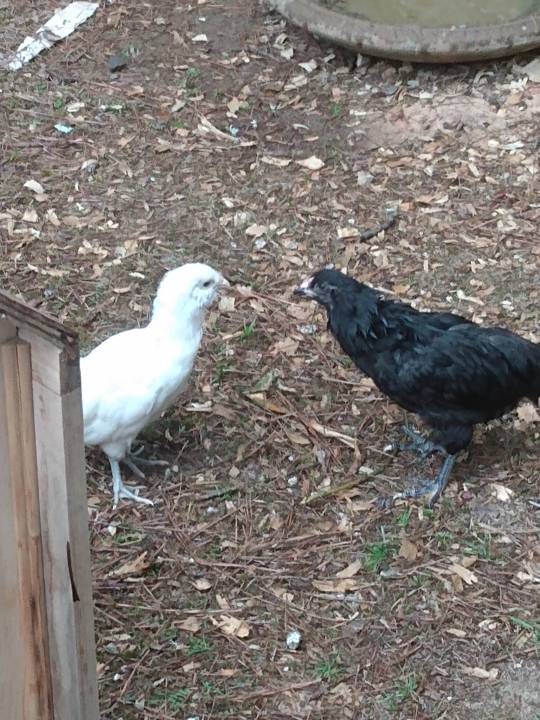
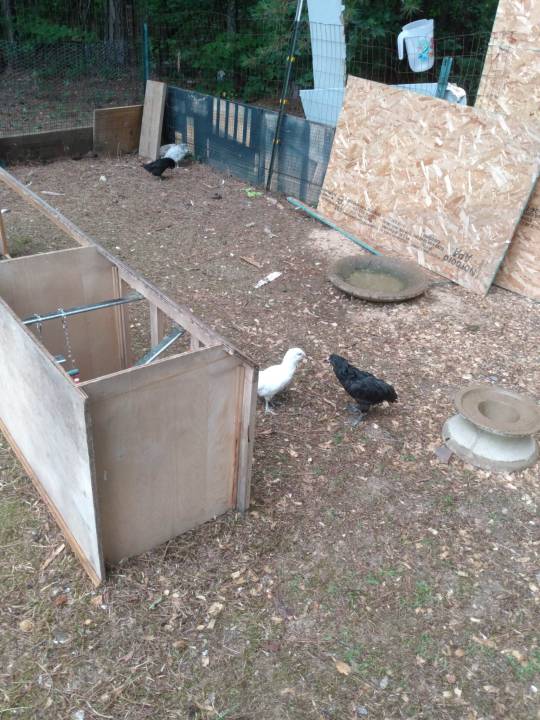
Bean and Roostifer stare contest.
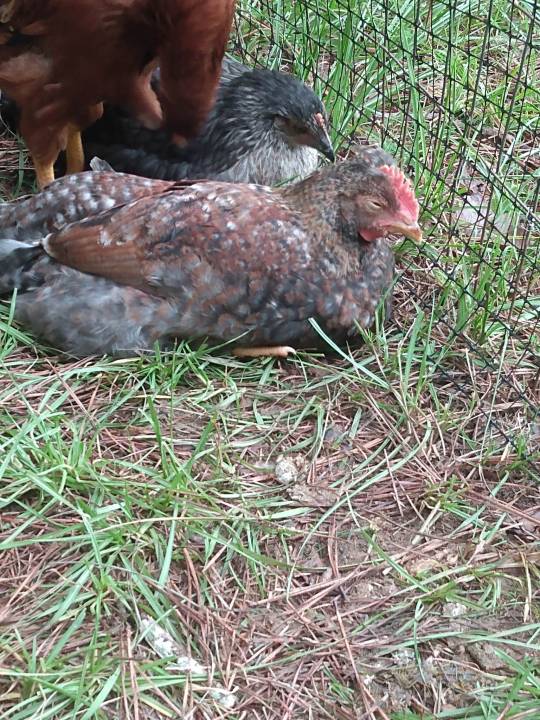
Nugget and Indominus napping while Cinnamon flaps frantically

Hillary Cluck, one of the Legbars.
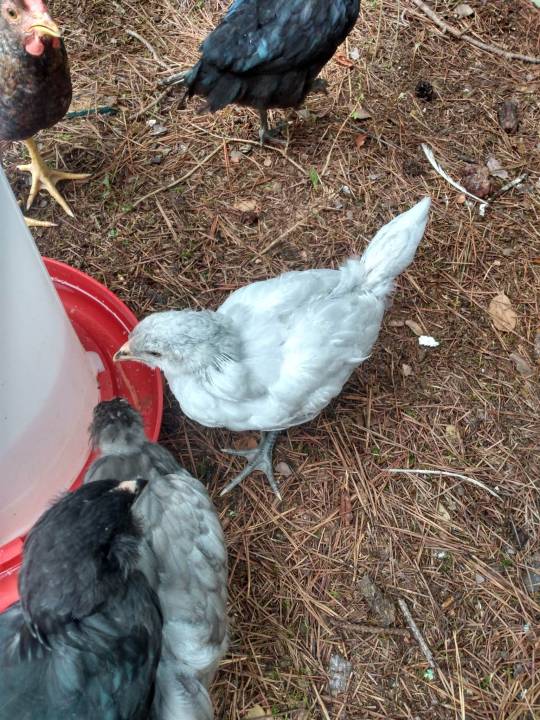
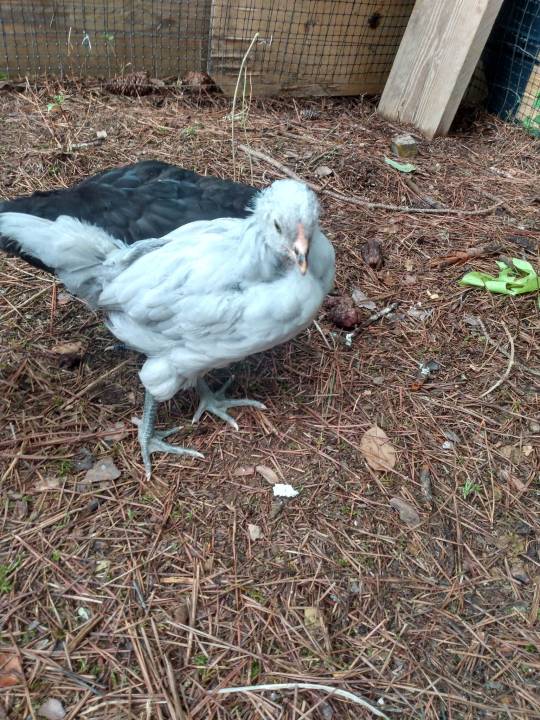
Please say hello to Dai, one of our two lavender Ameraucanas.
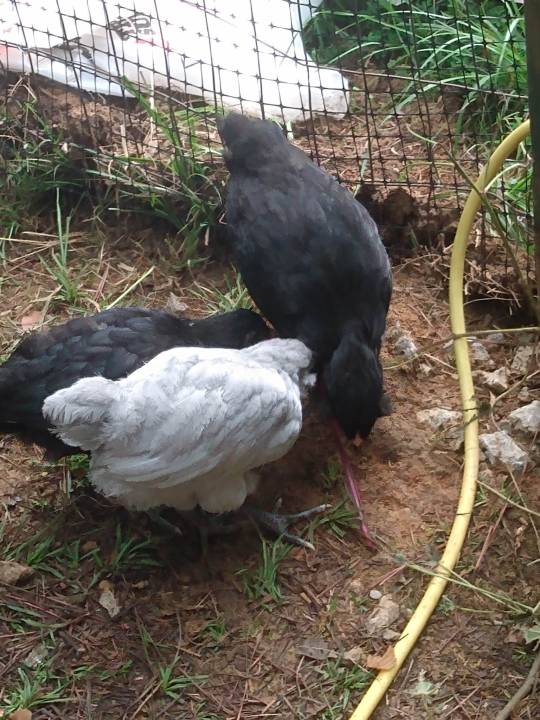
Wave, our other lavender girl, fighting with siblings over something.
Yes, I have been given permission to name more chickens after transformers. The lavender girls are very majestic and beautiful, and I thought naming them after the Senator boys, Dai Atlas and Shockwave, was fitting >v>

Fortress Maximus and his little white glove-wings. A sweet baby. :3
#zefposting#chicken#backyard chickens#cute animals#zef and sister's chimkin adventures#morgoth the destroyer#morgy the chimkin#snowflake the chimkin#pretty boy the chimkin#jeff the chimkin#olive the chimkin#bean the chimkin#cinnamon the chimkin#hennifer the chimkin#grub the chimkin#worm the chimkin#peanut the chimkin#walnut the chimkin#bird the chimkin#roostifer the chimkin#hillary the chimkin#indominus rex the chimkin#dai the chimkin#wave the chimkin#fort max the chimkin#so many chimkins
15 notes
·
View notes
Note
If you were able to have a small flock of chickens (3-10), what breed or breeds of chickens would you pick? 🐔
You just opened a flood gate that I've literally been thinking of for decades. Strap in babe!
First of all: They wouldn't all by chickens; I want a flock of mixed fowl. It's been my dream for as long as I can remember. But if I'm limited to 10 as my max, this is the breakdown I'd go for to start, with the full intent on using them to breed me more:
3 Chicken (1 Ameraucana Hen, 1 Brahma Rooster, and 1 Egyptian Fayoumi Hen);
A Chinese Goose Pair (2);
A Golden Pheasant Pair (2);
3 Prairie Chickens (there's a conservation effort that allows you to hatch eggs for breeding and release)
3 notes
·
View notes
Note
You have chickens? What kind
I’ve got 11 hens! I have an appenzeller spitzhauben (the broody one), an Easter egger, an ameraucana, a sultan, a Dominique, a golden cuckoo maran, a silver spangled hamburg, a speckled sussex, a silver laced Wyandotte, a Colombian Wyandotte, and a lavender Orpington.
Their names in order are Sid Vicious, Horace, Dipstick, Genie P, Pepper, Pumpkin, Dewey, Cinnamon, Toki, Michael Wave, and Cloudy
Do you have chickens?
4 notes
·
View notes
Link
Can Ameraucana Bantams Make Good Pets? Unlock the Mystery of the Blue Ameraucana Rooster! Unlock the Mystery of Blue Ameraucana Hens! What Makes Blue Ameraucana Eggs Special? What Makes Blue Ameraucana Bantams Unique? What Makes Blue Ameraucana Large Fowl So Special? The Ameraucana Breeders Club is an association devoted to the breeding, exhibition and improvement of Ameraucana bantams and large fowl. The Ameraucana Breeders Club also encourages the exchange of relevant information. Members of the club are encouraged to breed their own birds and share their knowledge about the breed. https://backyardchickennews.com/can-ameraucana-bantams-make-good-pets/?feed_id=3447&_unique_id=65b0fc467a7b6
0 notes